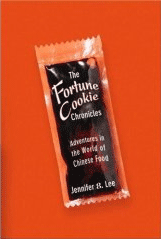« The Chicago Tribune: “An information-packed page-turner” | Home | Newsweek! An interview at Tang Pavilion »
Newsday says book smacks like chop suey: rich medley of flavors, odds and ends
By Jennifer 8. Lee | March 2, 2008
Newsday’s review is more mixed, generally positive with its main criticism (which is not unfair) being:
“The Fortune Cookie Chronicles” offers a rich medley of flavors that would be more delicious had the chef exercised some restraint: A clearer chronology and narrative line would allow each ingredient to sing. As it stands, Lee’s concoction, although tasty, smacks at times of chop suey – that catchall dish that translates from Cantonese as “odds and ends.” (full review after the jump)
The hardest part of constructing the book was coming up with a structure that I could hang everything on. It’s true. And I tried to have the thread carry us through, so a reader buys into it or doesn’t. ( The Fast Company criticism about it congealing like MSG-laden sauce is similar.)
Review: ‘The Fortune Cookie Chronicles’
BY HELLER McALPIN
Special to Newsday
THE FORTUNE COOKIE CHRONICLES: Adventures in the World of Chinese Food, by Jennifer 8. Lee. Twelve, 308 pp., $24.95.
Years ago, at a Japanese
Another surprising morsel that Lee serves up in “The Fortune Cookie Chronicles: Adventures in the World of Chinese Food” is that there are some 40,000 Chinese restaurants in the United States – more than twice the number of McDonald’s, and more than all the stateside McDonald’s, Burger Kings and KFC’s combined. In fact, Lee claims, Chinese food has become a more pervasive part of the American diet than the traditional “benchmark for Americanness,” apple pie. What’s going on?
Lee, an American-born Chinese – sometimes called “ABC” – got pulled into a three-year quest “to unravel the nagging mysteries of Chinese food in America” after a statistically improbable number of people won second prize in a 2005 Powerball lottery – most of whom, it turned out, had gotten their numbers from fortune cookies.
As Lee quickly discovered, American Chinese food – from chop suey to General Tso’s Chicken – bears little resemblance to authentic Chinese cuisine. For starters, American Chinese food is sweeter, meatier and often fried. Real Chinese food is bonier, less oily, and heavier in pickled and dried ingredients. “Chinese restaurants in America tend to shy away from anything that is recognizably animal,” Lee writes. Americans favor chicken breasts, while Chinese prefer more flavorful chicken feet. Fish in China are served whole, eyeballs intact. Lee explains, “But perhaps most important in American eating is the idea that what goes in the mouth should never come out. That is, there should be nothing where you have to chew on something and then spit out the inedible part.”
Lee’s fluency in Mandarin Chinese, along with reporting skills honed as a
Lee’s inquiries, which span six continents, 23 countries and 42 states, are at times jumbled and overwhelming. In a not entirely successful effort to tie together an often unwieldy book, she returns repeatedly to the history of fortune cookies, using their infiltration into Chinese cuisine as a bellwether of other cross-cultural changes.
More compelling are her stories – often adapted from articles she first wrote for the Times – about Chinese immigrants in the restaurant business. Among these are the young man from Fuzhou, China, who spent four years incarcerated in
Another Fuzhou family pursuing their “wok-fueled American dream” isn’t so successful. Their story bears similarities to the one told in Ha Jin’s recent novel, “A Free Life.” After years slaving in others’ restaurants, the couple manage to bring their three children over from China and buy a small restaurant in Hiawassee, Ga. Cultural and language barriers, plus a miserable, manipulative teenage daughter, lead a child welfare agency to put their children in foster care until a Good Samaritan from their church intervenes on their behalf.
Readers are likely to increase their tips after reading about the plight of Chinese restaurant workers, who, lacking English and papers, are often “treated like farm animals or machines.” Lee focuses in particular on the poor deliveryman who went missing for three days, stuck in an elevator for almost 81 hours after making a delivery to a large apartment building in the Bronx.
“The Fortune Cookie Chronicles” offers a rich medley of flavors that would be more delicious had the chef exercised some restraint: A clearer chronology and narrative line would allow each ingredient to sing. As it stands, Lee’s concoction, although tasty, smacks at times of chop suey – that catchall dish that translates from Cantonese as “odds and ends.”
Topics: Chop Suey, Reviews | No Comments »
Comments are closed.

